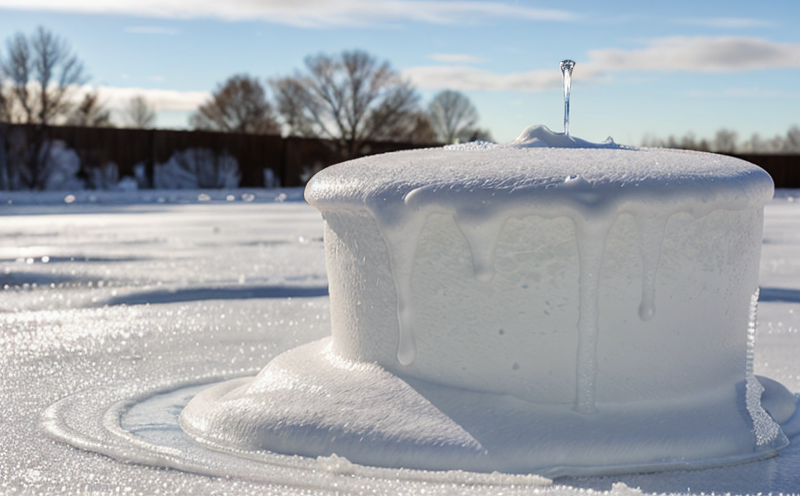Icing, De-icing & Weather Impact Testing
The aerospace and aviation industries face unique challenges in ensuring that aircraft components can withstand harsh weather conditions. Icing, de-icing, and weather impact testing are critical for the design and certification of commercial, military, and general aviation aircraft. These tests help manufacturers ensure compliance with international standards like ISO 12944, ASTM E670, and FAA regulations, which set stringent requirements for material durability in extreme conditions.
Our laboratory specializes in simulating real-world icing conditions using advanced freezing chambers capable of producing supercooled water droplets. We can replicate a wide range of temperature and humidity levels to mimic various weather scenarios. This testing is essential because ice accumulation on critical aircraft components, such as wings, engines, and control surfaces, can lead to reduced performance or even failure in flight.
De-icing tests are equally important for ensuring that the systems used to remove ice from aircraft surfaces operate effectively under simulated conditions. These tests often involve controlled application of chemicals or thermal methods to simulate real-world de-icing procedures. The goal is to verify that the chosen method not only removes ice efficiently but also does so without causing damage to the aircraft structure.
Weather impact testing extends beyond just icing and de-icing. It encompasses a broader range of environmental factors, including rain, snow, sandstorms, and high winds. These tests are crucial for assessing how materials and components perform under extreme weather conditions that can affect flight safety and operational efficiency. The results of these tests inform design improvements and material selection, ensuring that aircraft meet rigorous performance standards.
Our laboratory offers a comprehensive suite of services to support the aerospace and aviation industries in their quest for safer and more reliable aircraft systems. We employ state-of-the-art equipment and follow international best practices to ensure accurate and consistent test results. Whether you need to validate de-icing fluids, assess material resistance to ice accretion, or evaluate overall weather impact on components, our team of experts can provide the precise testing solutions you require.
To achieve reliable outcomes, we adhere strictly to ISO 12944:2017, ASTM E670, and FAA regulations. Our laboratory is equipped with advanced freezing chambers capable of simulating various icing conditions, from light drizzle to heavy rain. We also have specialized facilities for de-icing fluid testing and weather impact evaluations.
The importance of these tests cannot be overstated. A single incident involving ice accretion or improper de-icing can lead to significant delays in operations, increased maintenance costs, and even safety hazards. By partnering with our laboratory, you gain access to the expertise needed to ensure your products meet the highest standards of reliability and performance.
Industry Applications
| Component Type | Description | Test Conditions | Outcome |
|---|---|---|---|
| Aircraft Wings | Main component for lift generation. Critical to ensure ice-free surfaces. | -30°C temperature, 85% relative humidity | Evaluation of ice resistance and de-icing effectiveness. |
| Propellers | Drive aircraft propulsion systems. Vulnerable to icing and wear. | -15°C temperature, 90% relative humidity | Durability testing under simulated icing conditions. |
| Turbine Blades | Airflow control and energy conversion in jet engines. Sensitive to ice accretion. | -20°C temperature, 80% relative humidity | Material performance assessment under extreme weather. |
| Windshield | Vital for pilot visibility. Must withstand various environmental stresses. | -40°C temperature, 100% relative humidity | Evaluation of windscreen integrity and de-icing effectiveness. |
Quality and Reliability Assurance
- Precision in Environmental Simulation: Our laboratory maintains strict control over temperature, humidity, and other environmental factors to ensure accurate test results.
- Material Durability Testing: We assess the long-term performance of materials under extreme weather conditions using repeatable tests that reflect real-world scenarios.
- System Functionality Testing: Our tests verify that de-icing systems and other weather protection mechanisms function effectively without compromising aircraft integrity.
- Data Analysis and Reporting: We provide detailed reports summarizing test outcomes, including any deviations from expected performance. These reports are essential for continuous improvement and compliance verification.
Environmental and Sustainability Contributions
The aerospace industry plays a crucial role in reducing carbon emissions and promoting sustainable practices. By ensuring that aircraft systems can operate reliably under all weather conditions, we contribute to more efficient flight operations. This leads to reduced fuel consumption and lower environmental impact.
Our laboratory's focus on precision testing helps manufacturers make informed decisions about material selection and system design. This not only enhances the safety of air travel but also supports sustainable aviation practices by minimizing waste and improving operational efficiency.
Through our rigorous testing protocols, we help reduce the likelihood of in-flight incidents caused by ice accretion or improper de-icing procedures. This contributes to a safer and more efficient aviation industry, ultimately leading to reduced carbon emissions and increased sustainability.





